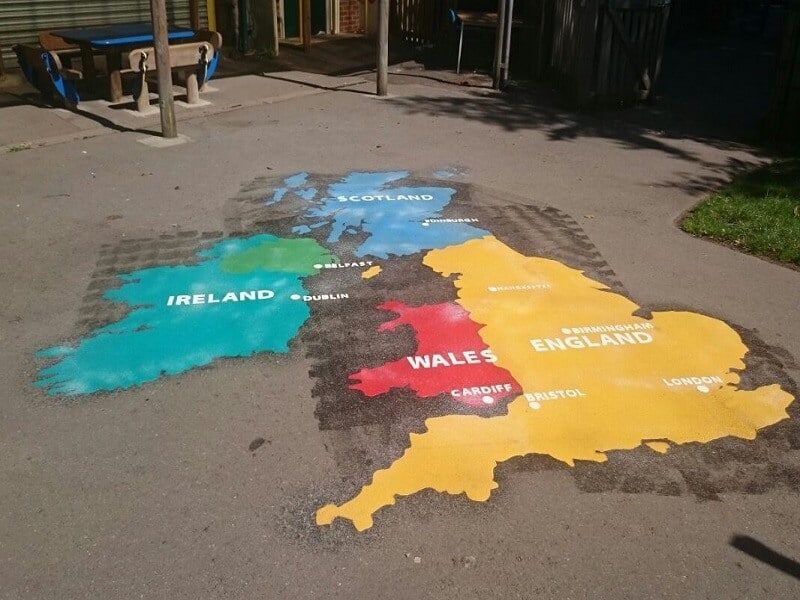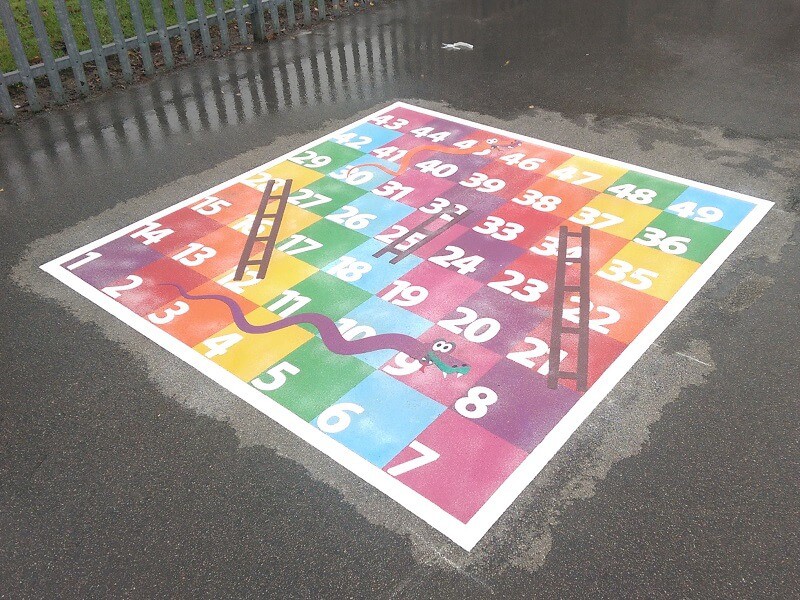20+ Years Experience
Specialist Playground Markings

Inclusive playground design is a concept that focuses on creating play areas that are safe, accessible, and enjoyable for children of all abilities. It ensures that every child, regardless of their physical capabilities or sensory sensitivities, can actively participate in play and experience the benefits that playtime brings.
Inclusive playground design goes beyond just providing wheelchair ramps or accessible swings – it involves thoughtful consideration of physical, sensory, and social aspects to ensure that every child feels included and can fully engage in play activities. The importance of inclusive play areas cannot be overstated.
Inclusive play is crucial for children as it promotes social interaction, empathy, and understanding among peers. It also fosters a sense of belonging and acceptance, encouraging children to develop positive relationships and learn from one another.
Creating inclusive playgrounds comes with various considerations. Physical accessibility involves designing pathways, entrances, and equipment that can be easily navigated by children with different mobility needs.
Sensory accessibility focuses on providing a variety of sensory experiences, catering to children with sensory processing disorders or sensitivities.
Social inclusion involves creating opportunities for children to interact, collaborate, and play together, irrespective of their abilities. inclusive playgrounds should have equipment and play structures that cater to a wide range of abilities and encourage inclusivity.
Ensuring the safety of an inclusive play area is of utmost importance. It involves using safe surfacing materials to prevent injuries from falls, installing appropriate signage and wayfinding to guide children and parents, and regularly maintaining and inspecting equipment to ensure its safety and functionality.
Designing an inclusive playground should involve the community to garner insights and perspectives from different stakeholders. Consulting with children and parents allows for their input and feedback, ensuring that their needs and preferences are taken into account.
Collaborating with local organisations and experts, such as occupational therapists or disability advocates, can provide valuable guidance and expertise in creating a truly inclusive play environment.
Promoting inclusivity and diversity in play extends beyond the physical space. Education and awareness programs can help raise awareness about the importance of inclusive play and debunk myths and misconceptions surrounding disability.
Organising inclusive play events can create opportunities for children of all abilities to come together, play, and celebrate diversity. By embracing inclusive playground design and following these guidelines, we can create safe and accessible play areas that allow all children to have equal opportunities for play, growth, and development.
Understanding inclusive playground design is crucial for creating a secure and accessible play area for all children. The following are key elements to consider:
Pro-tip: It is advisable to consult with parents, caregivers, and disability organisations to gather insights and feedback, ensuring that the playground truly meets the needs of all children.
Creating inclusive play areas is crucial to ensure that all children, irrespective of their abilities, can engage in play and social interaction. Here are some reasons why inclusive play areas are important:
Inclusive play is important for children as it promotes social, emotional, and cognitive development. It allows children of all abilities to interact and learn from one another, building empathy and understanding.
Inclusive play also boosts self-confidence and self-esteem, as children feel included and accepted by their peers. It helps to break down barriers and stereotypes, fostering a sense of belonging and diversity.
Research has shown that inclusive play can have a positive impact on academic performance and overall well-being.
Inclusive play is not only about physical accessibility, but also about creating a welcoming and inclusive environment that celebrates the unique abilities and qualities of each child.
Studies have shown that inclusive playgrounds can reduce bullying and foster a sense of community among children.
Inclusive playgrounds offer numerous benefits for children of all abilities and backgrounds. Here are some of the key advantages they provide:
Pro-tip: When designing an inclusive playground, ensure that it includes a variety of activities that cater to different abilities, interests, and sensory needs, promoting a truly inclusive and accessible play experience for all children.
Designing an inclusive playground requires careful thought and consideration. To create a safe and accessible play area for all children, it is important to take into account several key considerations.
These considerations include physical accessibility, sensory inclusivity, promoting social inclusion, and incorporating the appropriate playground markings, equipment and play structures.
Ensuring physical accessibility is essential when designing an inclusive playground. Here are some key considerations for creating a safe and accessible play area for all children:
Fact: According to a study, inclusive playgrounds that prioritise physical accessibility benefit not only children with disabilities but also promote social inclusion and encourage empathy among all children.
Sensory accessibility is an important aspect to consider when designing inclusive playgrounds for all children. Here are some factors to incorporate for a sensory-friendly play environment:
Social inclusion is an essential aspect of designing inclusive playgrounds. It ensures that all children, regardless of their abilities, can participate and interact with their peers. Here are some key considerations for promoting social inclusion in playground design:
By prioritising social inclusion in playground design, we can create safe and inclusive spaces where children can develop friendships, enhance social skills, and experience the joy of playing together.
Inclusive playground markings refer to designs or graphics on the ground of a playground that are created with the intention of promoting inclusivity and accommodating children of all abilities.
These markings are often colourful, engaging, and designed to encourage social interaction, physical activity, and cognitive development among children. Inclusive playgrounds aim to provide a welcoming environment for children with diverse abilities, including those with physical, sensory, or cognitive challenges.
Key features of inclusive playground markings may include:
When designing an inclusive playground, it is important to consider the equipment and play structures to ensure accessibility for all children. Here are some key considerations to keep in mind:
By including inclusive equipment and play structures, inclusive playgrounds can provide a safe and enjoyable environment for all children to play and interact together.
Designing a safe inclusive play area is crucial when it comes to creating a safe and accessible play area for all children. This section will explore the key elements of designing a safe inclusive play area.
We will discuss the importance of safe surfacing materials, the role of appropriate signage and wayfinding, and the significance of ensuring proper equipment maintenance. By delving into these essential aspects, we can create an inclusive playground that caters to the needs of every child.
When designing a safe and inclusive playground, it is important to choose the right surfacing materials. Here are some options to consider:
Selecting the appropriate safe surfacing material ensures that children can play without the risk of serious injuries from falls.
When creating an inclusive playground, it is important to consider the use of appropriate signage and wayfinding. This ensures that children of all abilities can navigate the play area effectively. To create effective signage and wayfinding, follow these steps:
By implementing appropriate signage and wayfinding, inclusive playgrounds can provide a safe and accessible environment for all children to enjoy.
Proper equipment maintenance is essential for ensuring the safety and longevity of an inclusive playground. Here are some steps to follow:
Pro-tip: Create a maintenance schedule and assign responsibilities to staff or volunteers to ensure that equipment maintenance is consistently carried out.
Involving the community in the design process of an inclusive playground is essential to creating a play area that is safe and accessible for all children. By consulting with children and parents, and collaborating with local organisations and experts, we can ensure that the needs and preferences of the community are considered.
Involving the community in the design process of an inclusive playground is essential to creating a play area that is safe and accessible for all children. By consulting with children and parents, and collaborating with local organisations and experts, we can ensure that the needs and preferences of the community are considered.
When creating an inclusive playground, it is important to consult with both children and parents during the design process. This ensures that the play area meets the needs and preferences of the intended users.
Consulting with children allows them to provide input on what they would like to see in the playground, fostering a sense of ownership and inclusivity. Parents can offer valuable insights into the specific requirements and considerations for their children’s safety and accessibility.
By involving children and parents in the design process, the resulting playground will be more child-centred and better equipped to provide an inclusive and enjoyable experience for all.
Collaborating with local organisations and experts is crucial for the successful creation of an inclusive playground. By working together, these stakeholders can bring their unique perspectives and knowledge to the design process.
Local organisations, such as disability advocacy groups or community centres, can provide valuable insight into the needs and preferences of the diverse children in the area.
Experts in fields like accessibility or child development can offer guidance on best practices and ensure that the playground meets the appropriate standards. Through collaboration, these individuals and groups can create a safe and accessible play area that truly caters to the needs of all children.
Promoting inclusivity and diversity in play is essential for creating a safe and enjoyable environment for all children. To achieve this, consider the following strategies:
Inclusive playgrounds are designed to ensure that all children, regardless of their abilities or challenges, can play together and feel accepted. By incorporating a range of physical play elements, such as crawl tubes, slides, and swings, all children can interact with their surroundings and enjoy the play experience.
Inclusive playgrounds aim to promote interaction and understanding among children of all abilities and backgrounds. They provide opportunities for children to communicate with each other, even if they speak different languages or have physical impairments, creating a more inclusive and connected play environment.
Inclusive playgrounds incorporate cognitive play equipment, such as mazes or puzzles, to encourage problem-solving and develop children’s cognitive skills. This helps them build confidence and enhances their ability to think critically and creatively.
Accessible safety surfacing is a crucial element in inclusive playground design. It ensures that children with sensory or physical challenges can navigate the play area safely.
By meeting regulations, inclusive playgrounds provide equity in access and create a safe and healthy environment for all children to enjoy.
Inclusive playgrounds are designed with accessibility in mind. They provide play equipment that caters to diverse body sizes, abilities, and positions. This ensures that children of all developmental stages, from the youngest members to those with special education services, can all engage and have fun together.
Inclusive playgrounds should provide additional facilities nearby, such as toilets, water fountains, seating areas, and shade to enhance the overall experience.
Transparent sight lines and easy supervision are also essential to ensure child safety and provide peace of mind for parents, caregivers, and playground owners.








We Aim To Reply To All Enquiries With-in 24-Hours